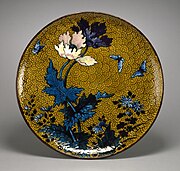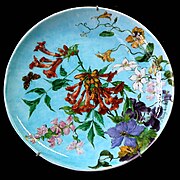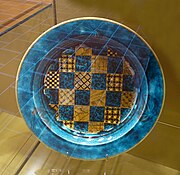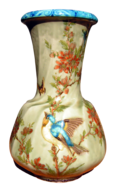Théodore Deck
- Machine translation, like DeepL or Google Translate, is a useful starting point for translations, but translators must revise errors as necessary and confirm that the translation is accurate, rather than simply copy-pasting machine-translated text into the English Wikipedia.
- Consider adding a topic to this template: there are already 6,170 articles in the main category, and specifying
|topic=will aid in categorization. - Do not translate text that appears unreliable or low-quality. If possible, verify the text with references provided in the foreign-language article.
- You must provide copyright attribution in the edit summary accompanying your translation by providing an interlanguage link to the source of your translation. A model attribution edit summary is
Content in this edit is translated from the existing French Wikipedia article at [[:fr:Théodore Deck]]; see its history for attribution. - You may also add the template
{{Translated|fr|Théodore Deck}}to the talk page. - For more guidance, see Wikipedia:Translation.

Joseph-Théodore Deck (2 January 1823 – 15 May 1891) was a 19th-century French potter, an important figure in late 19th-century art pottery. Born in Guebwiller, Haut-Rhin, he began learning the trade in his early 20s, moving to Paris at age 24. In 1856 he established his own faience (earthenware) workshop, Joseph-Théodore Deck Ceramique Française, and began to experiment with styles from Islamic pottery, and in particular the Iznik style.


When Japonisme arrived in the 1870s he embraced this and other art pottery trends with enthusiasm, finally conquering the French establishment when he was made art director of Sèvres porcelain in 1887. Several important figures from the next generation were trained by Deck, including Edmond Lachenal.[1]
In the 1880s he also worked in the Chinese pottery tradition, also collaborating with Raphaël Collin, and other artists of the time. He died in Paris. In 1887 he published a treatise under the title La Faïence, which is available in facsimile online.

Gallery
-
 Dish, 1866
Dish, 1866 -
 Vase with mythological scenes, 1869
Vase with mythological scenes, 1869 -
 Japanese inspired plate, c. 1875, Walters Art Museum, Baltimore
Japanese inspired plate, c. 1875, Walters Art Museum, Baltimore -
 Floral plate
Floral plate -
 Plate, decorated by Joseph Victor Ranvier, 1870s, Musée Unterlinden, Colmar
Plate, decorated by Joseph Victor Ranvier, 1870s, Musée Unterlinden, Colmar -
 Faïence vase, ca. 1870s, Musée Unterlinden, Colmar
Faïence vase, ca. 1870s, Musée Unterlinden, Colmar -
 Japanese inspired plate, c. 1875, Musée Unterlinden, Colmar
Japanese inspired plate, c. 1875, Musée Unterlinden, Colmar -
 Tile, decorated by Joseph Victor Ranvier, 1870s, Musée Unterlinden, Colmar
Tile, decorated by Joseph Victor Ranvier, 1870s, Musée Unterlinden, Colmar - Plate, decorated by Raphaël Collin, Indianapolis Museum of Art
-

-
 Vase, signed by Joseph-Théodore Deck
Vase, signed by Joseph-Théodore Deck -
 Egyptian-style faïence cat,
Egyptian-style faïence cat,
Musée Théodore Deck, Guebwiller -
 A home in Guebwiller decorated with Deck's portrait
A home in Guebwiller decorated with Deck's portrait
Sources
- ^ "Théodore Deck and the Islamic Style", by Frederica Todd Harlow, from Aramco World; Sullivan
- Ceramics Today, Théodore Deck and the Islamic Style Archived 2009-09-09 at the Wayback Machine
- CBS Resource Library, Théodore Deck
Bibliography
- Théodore Deck, La faïence, Quantin, Paris, 1887. 300 p., complete text online at Gallica
- À la Mémoire de Théodore Deck. Érection d'un Monument à Guebwiller (Alsace), sa ville natale, J. Dreyfus impr, Guebwiller?, 1911?
- Jules-Antoine Castagnary, « Théodore Deck », in Revue Alsacienne, 1880
- Antoinette Faÿ-Hallé, Françoise Fournière, Brigitte Grenier et al. (dir.), Théodore Deck ou L'éclat des émaux, 1823–1891 (exposition catalogue, Marseille, Centre de la Vieille Charité, 1994, organized by the Musée Grobet-Labadié), Musées de Marseille, Marseille, 1994, ISBN 2-9500996-7-X
- André Girodie, « Biographies alsaciennes : Théodore Deck », in Revue Alsacienne illustrée, 1903, vol. V
- André Girodie, Un céramiste alsacien : Théodore Deck, Art & Industrie, Nancy, 1912
- J. Loebnitz, Article nécrologique sur M. Théodore Deck, in La Céramique et la verrerie, 1891?
- Sandor Kuthy, Albert Anker, faiences, en collaboration avec Théodore Deck, Marguerat, Lausanne, 1985
- Alexandre Meichler (intro.), Théodore Deck : magicien du feu (1823–1891) (exposition catalogue, Guebwiller, City Hall, 1976), Alsatia, Guebwiller, 1976
- Théodore Deck (catalogue de l'exposition au Musée Cantini, Marseille, 1980), Le Musée, Marseille, 1979?
- Théodore Deck : la véranda des glycines, Musée du florival, Guebwiller, 1989
- Théodore Deck : 1823–1891 (préface Charles Haby), Musée du Florival, Guebwiller, 1991, ISBN 2-908367-20-3
External links

- Musée Théodore Deck, Théodore Deck Museum, City of Guebwiller, France
- Deck and the Islamic Style
- Théodore Deck in American public collections, on the French Sculpture Census website
























